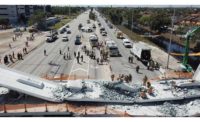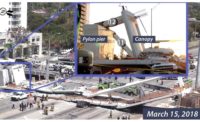Editorial
NTSB Must Clarify Fla. Bridge Tragedy Disputes at Oct. 22 Hearing

If there’s one thing clear about the National Transportation Safety Board’s recent release of documents on last year’s Florida International University bridge collapse, it’s that the spin machines have been running at full speed. As expected, contractor MCM and engineer FIGG Bridge Engineers, the pedestrian bridge’s contractor-led design-build team, have accused each other of being at fault.
NTSB is due to make a presentation on Oct. 22 setting the stage for its final report on the disaster. The board can do engineering and construction a big favor if, in addition to assessing the causes, it defines two key industry concepts that are at the center of the MCM-FIGG collapse arguments.
The federal report should define 'redundancy' and 'constructibility' as they relate to the Florida disaster.
The first is constructibility, as it relates to the bridge design’s independent peer review.
Required constructibility was spelled out in the Florida Dept. of Transportation’s peer review scope.
Conducted by Louis Berger Group under a $61,000 contract with FIGG, the review has become a flash point.
Berger was contracted to develop a finite element model, determine what was needed for each bridge element, and review foundation, substructure and superstructure plans. The contract did not specify review of twisting loads when the unusual concrete truss structure was rolled into place, nor did the review include all calculations needed for nodes and connections.
Berger certified that the peer review was conducted according to state rules, but FIGG now claims that “Louis Berger, unbeknownst to FIGG, completely failed in their role” by not analyzing loads when the bridge was moved and not reviewing truss connections in greater detail.
Why none of this came up during the project or after several months of peer review is unclear. NTSB needs to shed light on who was responsible for the limited review scope.
A more important concept is redundancy in the bridge design. A U.S. Labor Dept. OSHA report on the disaster released in June criticized FIGG for producing a bridge design that is non-redundant.
The report defined redundancy as multiple load paths that would prevent total collapse if one structural component or system failed.
FIGG argues that there are two other types of redundancy in addition to load paths. One is internal redundancy, in which a member is composed of multiple parallel elements. Another is a different type of structural redundancy, the engineer says, “due to static indeterminacy such as structures continuous over support.”
The company says it provided the pedestrian bridge design with redundant features that include multiple parallel reinforcing bars and/or prestressing tendons and a continuous superstructure at completion.
FIGG also says there are no state or federal code provisions specifically related to redundancy for concrete bridges.
NTSB's effort to clarify and verify these arguments would help industry peers take important lessons from the Florida tragedy and from the consequences now unfolding.


